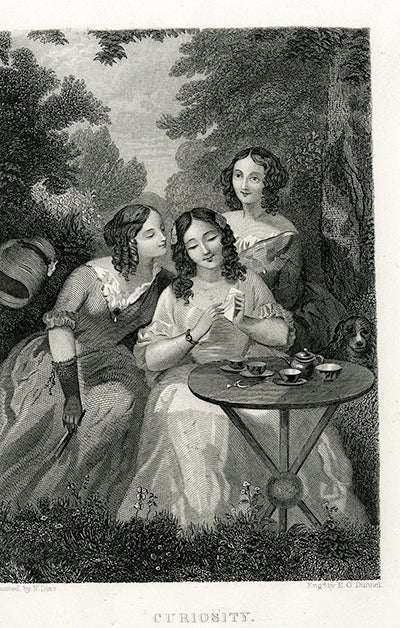
Engraving: “Curiosity” by E.G. Dunnel,
painted by N. Diaz, no date,
in Cherished Memories,
a 19th century woman’s scrapbook (GTM170130)
The vast quantity and infinite research potential of primary sources can be daunting so that it is often difficult to know where to start. Selection of a primary source or archival item may be the first action, followed by deciding what to write about it. It is often necessary to assess the research potential of an item before defining the research topic. Sometimes it’s easier to start with the item, if only because you like it!
Selecting an item for research involves an assessment of its research potential. Considering the following criteria can help to identify a promising item.
- Legibility – Can you read it?
- Contextual value – Does the content provide information about and insight into the item. Could a narrative or backstory be construed?
- Multiple perspectives – How many angles could you approach to writing about the item? Can you identify multiple related subjects? Example: For an item created by a 19th century woman, related subjects can include women’s history, literacy, civil rights, work or occupations.
- Availability of secondary sources for further research (e.g., related published articles, books providing additional information on the context and subjects of the item).
Next, define a research topic or question. Good ones are typically specific and narrow. If the topic is broad, the amount of information available will be difficult to synthesize into a finite project. Developing a good research topic can be challenging; however, instructors, librarians and archivists can offer invaluable assistance here because they are familiar with pertinent information resources, and are likely to have helped other researchers with a similar area of interest. When defining a research topic, it helps to
Identify parameters of the topic – Narrow the focus of the topic by
- Subjects
- Geographical location(s)
- Dates
Find archival/special collections that match the topic
- Library research guides (arranged by topic or course) – help to identify both primary and secondary sources and often provide guides and tools for conducting research.
- Consult with librarians and archivists.
Find help on researching primary sources in the Special Collections guide on Archival Research.
Read more about researching primary sources in the “Making Sense of Evidence” series at HistoryMatters.GMU.edu
Look out for more of my blog posts on researching with manuscripts.
Lisette Matano, Manuscripts Archivist
February 27, 2017
